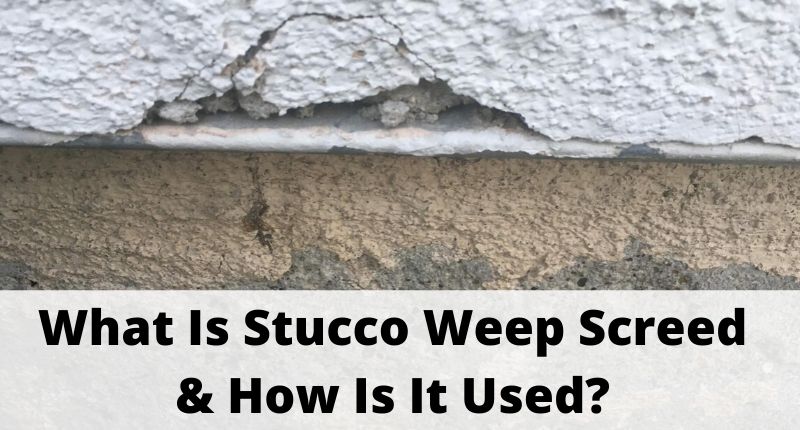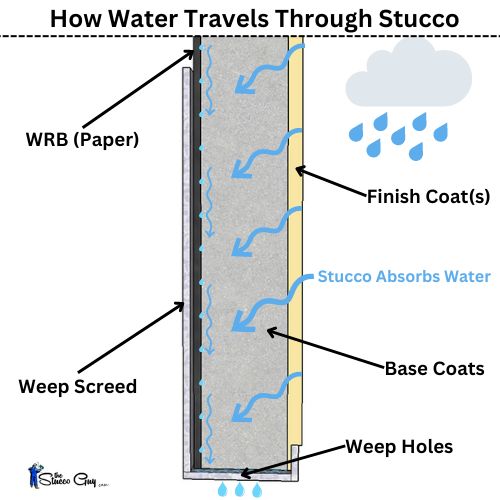
There are a few components of stucco that have people asking more questions than usual and stucco weep screed is one of those elements that always comes around.
Let's take a look at some of the most popular questions regarding weep screed and try to solve some of the mystery around weep screed.
What Is Stucco Weep Screed?
Weep screed is a special piece of metal flashing that runs along the bottom of walls that wicks moisture out of holes that are located at the bottom of the flashing. It also acts as a ground that helps establish the stucco depth of the wall and serves as a control joint that runs along the bottom of the stucco walls.
It hangs below the lower sill plate to ensure that the water wicks past any material (mainly wood) that could become damaged by excessive amounts of water.
What Does A Weep Screed Do?
The real purpose of weep screed is to direct any moisture that gets absorbed and trapped behind the stucco out of the system, below the plate line, where the concrete foundation starts. This is a safe area to dispatch the water and will not cause any damage to the foundation.
That is why the bottom of the weep screed hangs down below the sill plate anywhere from 1- 1 1/2". Any water that does weep out of the holes in the bottom will hit the concrete foundation, which is much more resilient to water than wood.
How Does Weep Screed Work?
Weep screed is really just a flashing that has a bend at the bottom edge and holes that run along the bottom. The back side is around 3 1/2" and is mounted to the wall, just like rolled flashing or "L" flashing would be mounted to the wall.
Stucco is designed to absorb water (most hard coat systems, anyways) and then the water evaporates but sometimes there is so much water that it actually will drain off of the stucco and, like everything else, water runs down hill and will end up running down the stucco wall.
This is why the weep screed is at the bottom of the stucco.
The water will then run out of the weep holes (away from wall assemblies) in the stucco, if there is an absorbent amount of water in the stucco system.

Do I Really Need Weep Screed?
This really is a matter of personal opinion and you will get different answers from different people.
The first point I want to make is that it is a required building code for most counties and you will have to comply with those codes if you are getting an inspection done (if required). You will have to install weep screed according to the local codes with all of the correct clearances, overlaps, etc.
I have worked on many projects that were built before weep screed were mandatory and they have held up just fine with the stucco running straight to the ground.
My personal opinion is that weep screed is a useful tool in the overall stucco application and it also makes for a nice and clean break between your foundation and your walls.
I would recommend using weep screed on every stucco project, unless you are matching an existing building that never used it and you want to match the rest of the house.
You will have to check if your local building department will allow such an exemption before you make that decision, though.
When Is Weep Screed Not Required?
This is a common question that comes up, but the answer is quite simple. Weep screed is usually required for all buildings that have wood framing construction, especially if it is a new build.
Existing Stucco: There are certain circumstances where an older building that did not have weep screed installed may be exempt from having weep screed installed when doing renovations due to aesthetics. If building permits are pulled for the project, you should contact the building department to verify if this would be okay to match the existing walls.
Concrete and Block Walls: Concrete and cinder block (cmu) walls do not require a weep screed either, since they are a cement based material and can handle water with no problems.
This would also include foundations, which sometimes do have a coat of stucco applied to them.
Where Can I Buy Weep Screed?
I have seen weep screed sold at Home Depot and Lowes, but the availability and options are not always a "sure thing". HD and Lowes will have three coat stucco weep screed (7/8") but usually only the #7 type and the "J" type is more limited but still available in certain locations.
A stucco supply yard is really the best choice because they will have both styles of weep screed in stock for a three coat and one coat system.
They will also have specialty weeps that are made from specialty metals (for certain areas susceptible to rust) and that come with different sized flanges too.
What Are The Different Types Of Weep Screed?
There are two main styles of weep screed and these are #7 and the "J" style. They both serve the same purpose and work equally as good, it just comes down to personal preference, I guess.
Type 7: The #7 weep screed is what you will likely find at Home Depot and Lowes and is the more common type used, especially on older buildings. It has a "V" shape to it which looks like a "&" I guess but I am not sure why it is called #7 weep screed.

#7 Weep Screed (clarkdietrich.com)
"J" Type: The "J" type of weep screed is less common and will likely be found at a stucco supply yard. From the side, it resembles a capital "J" and is probably why it is called "J" type, I am assuming.

"J" Type Weep (clarkdietrich.com)

